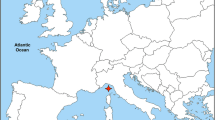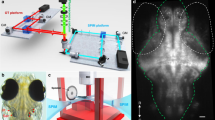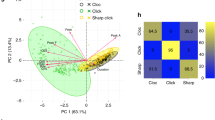Abstract
Many marine invertebrates and fish respond to hydrostatic pressure in order to regulate their depth and synchronize their behaviour to tidal cycles1,2,3,4. Here we investigate the effect of hydrostatic pressure on the vestibular hair cells located in the labyrinth of the dogfish Scyliorhinus canicula, and find that it modulates their spontaneous activity and response to angular acceleration. This may explain not only the low resting activity of vertebrate hair cells but also how fish that do not have swim bladders can sense hydrostatic cues.
This is a preview of subscription content, access via your institution
Access options
Subscribe to this journal
Receive 51 print issues and online access
$199.00 per year
only $3.90 per issue
Buy this article
- Purchase on Springer Link
- Instant access to full article PDF
Prices may be subject to local taxes which are calculated during checkout

Similar content being viewed by others
References
Macdonald, A. C. & Fraser, P. J. Comp. Biochem. Physiol. A 122, 13–36 (1999).
Hardy, A. C. & Bainbridge, R. Nature 168, 327–328 (1951).
Blaxter, J. H. S. in Environmental Physiology of Fishes (ed. Ali, M. A.) 369–386 (Plenum, New York, 1980).
Pavlov, D. S., Sadovskii, R. V., Kostin, V. V. & Lupandin, A. I. J. Fish Biol. 57, 69–81 (2000).
Digby, P. S. & Leach, B. Nature 191, 366–368 (1961).
Fraser, P. J. & Macdonald, A. G. Nature 371, 383–384 (1994).
Conradi, P. & Ulfendahl, M. Oto-Rhino-Laryngology 61, 57–62 (1999).
Lowenstein, O. & Compton, G. J. Proc. R. Soc. Lond. B 202, 313–338 (1978).
Dowse, H. B. & Ringo, J. M. Biol. Rhythm Res. 25, 1–13 (1994).
Author information
Authors and Affiliations
Corresponding author
Rights and permissions
About this article
Cite this article
Fraser, P., Shelmerdine, R. Dogfish hair cells sense hydrostatic pressure. Nature 415, 495–496 (2002). https://doi.org/10.1038/415495a
Issue Date:
DOI: https://doi.org/10.1038/415495a
This article is cited by
-
Movements of Juvenile Bull Sharks in Response to a Major Hurricane Within a Tropical Estuarine Nursery Area
Estuaries and Coasts (2020)
-
Tropical storms influence the movement behavior of a demersal oceanic fish species
Scientific Reports (2019)
-
Increase in telencephalic dopamine and cerebellar norepinephrine contents by hydrostatic pressure in goldfish: the possible involvement in hydrostatic pressure-related locomotion
Fish Physiology and Biochemistry (2015)
Comments
By submitting a comment you agree to abide by our Terms and Community Guidelines. If you find something abusive or that does not comply with our terms or guidelines please flag it as inappropriate.



